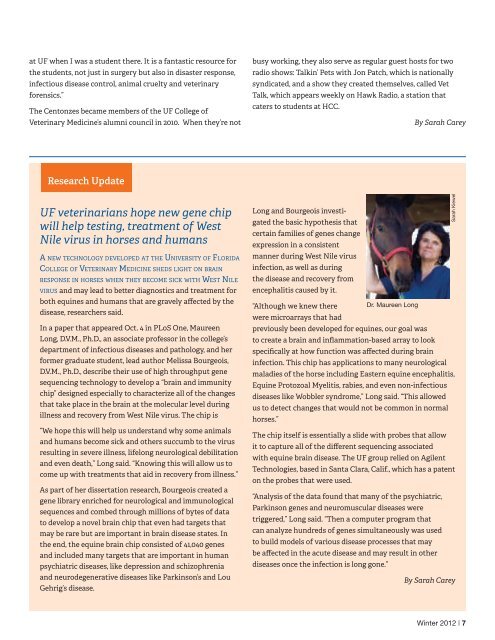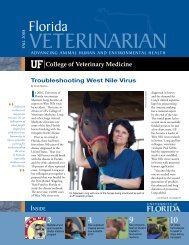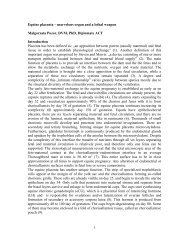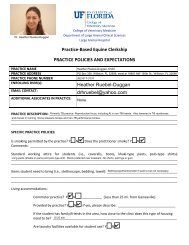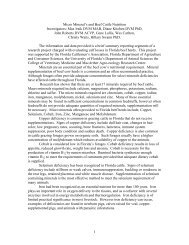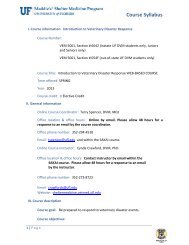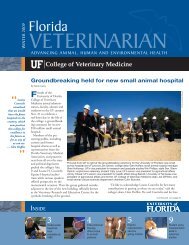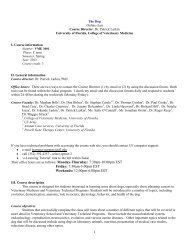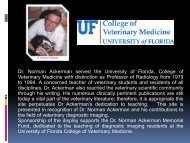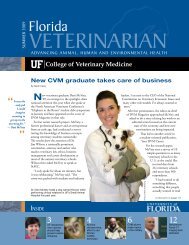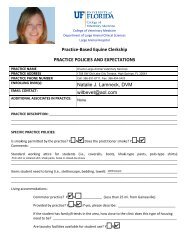Florida Veterinarian, Winter 2012 (PDF) - University of Florida ...
Florida Veterinarian, Winter 2012 (PDF) - University of Florida ...
Florida Veterinarian, Winter 2012 (PDF) - University of Florida ...
You also want an ePaper? Increase the reach of your titles
YUMPU automatically turns print PDFs into web optimized ePapers that Google loves.
at UF when I was a student there. It is a fantastic resource for<br />
the students, not just in surgery but also in disaster response,<br />
infectious disease control, animal cruelty and veterinary<br />
forensics.”<br />
The Centonzes became members <strong>of</strong> the UF College <strong>of</strong><br />
Veterinary Medicine’s alumni council in 2010. When they’re not<br />
busy working, they also serve as regular guest hosts for two<br />
radio shows: Talkin’ Pets with Jon Patch, which is nationally<br />
syndicated, and a show they created themselves, called Vet<br />
Talk, which appears weekly on Hawk Radio, a station that<br />
caters to students at HCC.<br />
By Sarah Carey<br />
Research Update<br />
UF veterinarians hope new gene chip<br />
will help testing, treatment <strong>of</strong> West<br />
Nile virus in horses and humans<br />
A n e w t e c h n o l o g y d e v e l o p e d a t t h e Un i v e r s i t y o f Fl o r i d a<br />
Co l l e g e o f Ve te r i n a r y Me d i c i n e s h e d s l i g h t o n b r a i n<br />
r e s p o n s e in h o r s e s w h e n t h e y b e c o m e s i c k w i t h We s t Ni l e<br />
v i r u s and may lead to better diagnostics and treatment for<br />
both equines and humans that are gravely affected by the<br />
disease, researchers said.<br />
In a paper that appeared Oct. 4 in PLoS One, Maureen<br />
Long, D.V.M., Ph.D., an associate pr<strong>of</strong>essor in the college’s<br />
department <strong>of</strong> infectious diseases and pathology, and her<br />
former graduate student, lead author Melissa Bourgeois,<br />
D.V.M., Ph.D., describe their use <strong>of</strong> high throughput gene<br />
sequencing technology to develop a “brain and immunity<br />
chip” designed especially to characterize all <strong>of</strong> the changes<br />
that take place in the brain at the molecular level during<br />
illness and recovery from West Nile virus. The chip is<br />
“We hope this will help us understand why some animals<br />
and humans become sick and others succumb to the virus<br />
resulting in severe illness, lifelong neurological debilitation<br />
and even death,” Long said. “Knowing this will allow us to<br />
come up with treatments that aid in recovery from illness.”<br />
As part <strong>of</strong> her dissertation research, Bourgeois created a<br />
gene library enriched for neurological and immunological<br />
sequences and combed through millions <strong>of</strong> bytes <strong>of</strong> data<br />
to develop a novel brain chip that even had targets that<br />
may be rare but are important in brain disease states. In<br />
the end, the equine brain chip consisted <strong>of</strong> 41,040 genes<br />
and included many targets that are important in human<br />
psychiatric diseases, like depression and schizophrenia<br />
and neurodegenerative diseases like Parkinson’s and Lou<br />
Gehrig’s disease.<br />
Long and Bourgeois investigated<br />
the basic hypothesis that<br />
certain families <strong>of</strong> genes change<br />
expression in a consistent<br />
manner during West Nile virus<br />
infection, as well as during<br />
the disease and recovery from<br />
encephalitis caused by it.<br />
“Although we knew there Dr. Maureen Long<br />
were microarrays that had<br />
previously been developed for equines, our goal was<br />
to create a brain and inflammation-based array to look<br />
specifically at how function was affected during brain<br />
infection. This chip has applications to many neurological<br />
maladies <strong>of</strong> the horse including Eastern equine encephalitis,<br />
Equine Protozoal Myelitis, rabies, and even non-infectious<br />
diseases like Wobbler syndrome,” Long said. “This allowed<br />
us to detect changes that would not be common in normal<br />
horses.”<br />
The chip itself is essentially a slide with probes that allow<br />
it to capture all <strong>of</strong> the different sequencing associated<br />
with equine brain disease. The UF group relied on Agilent<br />
Technologies, based in Santa Clara, Calif., which has a patent<br />
on the probes that were used.<br />
“Analysis <strong>of</strong> the data found that many <strong>of</strong> the psychiatric,<br />
Parkinson genes and neuromuscular diseases were<br />
triggered,” Long said. “Then a computer program that<br />
can analyze hundreds <strong>of</strong> genes simultaneously was used<br />
to build models <strong>of</strong> various disease processes that may<br />
be affected in the acute disease and may result in other<br />
diseases once the infection is long gone.”<br />
By Sarah Carey<br />
Sarah Kiewel<br />
<strong>Winter</strong> <strong>2012</strong> | 7


